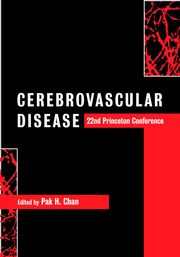Book contents
- Frontmatter
- Contents
- List of contributors
- Preface
- Acknowledgments
- Part I Special lectures
- Part II Oxidative stress
- Part III Apoptosis
- Part IV Hot topics
- Part V Hemorrhage, edema and secondary injury
- 14 The role of matrix metalloproteinases and urokinase in blood–brain barrier damage with thrombolysis
- 15 Does brain nitric oxide generation influence tissue oxygenation after severe human subarachnoid hemorrhage?
- 16 Tissue plasminogen activator and hemorrhagic brain injury
- 17 Dynamics of infarct evolution after permanent and transient focal brain ischemia in mice
- Part VI Inflammation
- Part VII Gene transfer and therapy
- Part VIII Neurogenesis and plasticity
- Part IX Magnetic resonance imaging in clinical stroke
- Part X Risk factors, clinical trials and new therapeutic horizons
- Index
- Plate section
15 - Does brain nitric oxide generation influence tissue oxygenation after severe human subarachnoid hemorrhage?
from Part V - Hemorrhage, edema and secondary injury
Published online by Cambridge University Press: 02 November 2009
- Frontmatter
- Contents
- List of contributors
- Preface
- Acknowledgments
- Part I Special lectures
- Part II Oxidative stress
- Part III Apoptosis
- Part IV Hot topics
- Part V Hemorrhage, edema and secondary injury
- 14 The role of matrix metalloproteinases and urokinase in blood–brain barrier damage with thrombolysis
- 15 Does brain nitric oxide generation influence tissue oxygenation after severe human subarachnoid hemorrhage?
- 16 Tissue plasminogen activator and hemorrhagic brain injury
- 17 Dynamics of infarct evolution after permanent and transient focal brain ischemia in mice
- Part VI Inflammation
- Part VII Gene transfer and therapy
- Part VIII Neurogenesis and plasticity
- Part IX Magnetic resonance imaging in clinical stroke
- Part X Risk factors, clinical trials and new therapeutic horizons
- Index
- Plate section
Summary
Introduction
Nitric oxide (NO) is now believed to be involved in many physiological events, especially vasoregulation. In the brain, NO has been implicated in retrograde neurotransmission, synaptic plasticity and vasomotor control. NO leads to vasodilation by diffusing across all membranes, and interrelates with guanylate cyclase in the smooth muscle, as its primary receptor target, thus regulating cerebral perfusion and cerebral blood flow (CBF). NO is rapidly synthesized on demand by nitric oxide synthase (NOS), which is present in a wide variety of tissues, including endothelial cells. Three isoforms of NOS are described, and all of them are expressed in the brain. The constitutive, endothelial and neuronal NOSs are believed to be primarily responsible for cerebral perfusion.
In neurons, NO release is stimulated by the excitatory amino acid glutamate via N-methyl-d-aspartate receptors. The NO then acts as a retrograde or orthodox neurotransmitter. Endothelial cells may supply tonically released NO that influences cerebral resistance vessels; however, the presence of NOS in glial and neuronal cells makes it likely that the coupling of CBF and neuronal activity is achieved via NO activity. The vasodilatory function of NO may be reduced after subarachnoid hemorrhage (SAH), due to reduced NO production or a disturbance of the basal vasomotor balance. Endothelial NO is profoundly reduced in some forms of experimental ischemia, leading to compensatory induction of NOS. Hemoglobin derived from the blood and oxyhemoglobin in the subarachnoid space (after SAH) binds to NO, thereby reducing its vasodilating effect.
- Type
- Chapter
- Information
- Cerebrovascular Disease22nd Princeton Conference, pp. 172 - 180Publisher: Cambridge University PressPrint publication year: 2002



